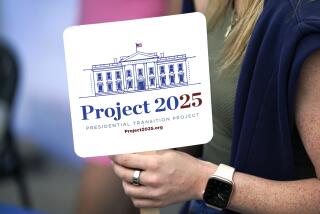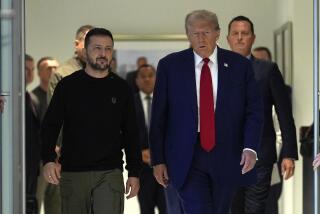Trump keeps shifting goals on North Korea, from ‘fire and fury’ to denuclearization to a meet-and-greet
Reporting from Washington — Nine months after he threatened to unleash “fire and fury like the world has never seen,” President Trump has sharply moderated his goals for next week’s nuclear summit with North Korean leader Kim Jong Un, a shift shaped in large part by competing foreign policy camps in his inner circle.
Two weeks ago, Trump said North Korea must dismantle its nuclear arsenal and infrastructure “over a very short period of time.” Secretary of State Mike Pompeo went further, calling for “rapid denuclearization, total and complete, that won’t be extended over time.”
For the record:
9:00 a.m. June 6, 2018An early version of this story incorrectly said Victor Cha, a Korea expert, had served in the Obama White House. He was Asia director on the National Security Council from 2004 to 2007 under President George W. Bush.
But by last Friday, after welcoming a senior North Korean envoy into the Oval Office, Trump conceded that ambitious objective was probably impossible when he faces Kim in Singapore on June 12.
“Wouldn’t it be wonderful if we walked out and everything was settled all of a sudden from sitting down for a couple of hours?,” he told reporters outside the White House. “No, I don’t see that happening. But I see [it] over a period of time. And frankly, I said, ‘Take your time.’”
The latest head-swerving shift in Trump’s approach to North Korea’s nuclear threat appeared a direct brushback to his national security advisor, John Bolton, a hard-line hawk who had pushed the upfront and all-at-once disarmament scenario. It was widely noted that Bolton did not take part in the Oval Office meeting.
Bolton had infuriated North Korea’s leaders last month when he suggested they follow the “Libya model,” presumably a reference to when Libyan leader Moammar Kadafi voluntarily gave up his nascent nuclear program in 2003 — and not the overthrow of the Kadafi government, and his brutal slaying, several years later.
Alarmed that the summit was in danger, Trump publicly distanced himself from Bolton’s provocative comments. “The Libya model isn’t the model that we have [in mind] at all when we’re thinking of North Korea,” Trump said on May 17. “In Libya we decimated that country.”
It didn’t work. A flurry of angry rhetoric from Pyongyang led Trump to withdraw from the summit on May 24. He reversed course again last week, saying the summit was back on, after U.S., South Korean and North Korean diplomats worked overtime to sideline the dispute.
Trump told associates in private that he was furious with Bolton for his choice of words and blamed him for spooking the North Koreans.
Few experts saw the instant-disarmament model as remotely plausible in any case.
South Korea and Japan argued for a more nuanced diplomatic approach, one that would entice Kim into cooperating. Kim, they noted, was eager for the summit to help establish his bona fides as a global leader.
Similarly, within the Trump administration, a camp opposing Bolton had been gaining traction. Some advisors worried that the president had set unattainable goals, and that he might agree to a deal in Singapore, perhaps by drawing down U.S. troops in South Korea, that could be potentially dangerous to U.S. interests.
Senior State Department officials feared Bolton was setting Trump up for failure. After Pompeo was confirmed as secretary of State on April 26 — shortly after he had made a secret trip to Pyongyang as CIA director — he began to stake out a counterbalance to Bolton.
He and others concluded that any likely North Korean disarmament would require a step-by-step approach, with clearly delineated goals at each phase, and reciprocal concessions by the United States and its allies to keep the process moving.
“It’s obvious that there will be multiple steps to any denuclearization,” said Susan Thornton, the acting assistant secretary of State for Asia, who has dealt with North Korea in the past.
The summit “will be the beginning of a process,” she said at a conference in Tokyo last month, the same words Trump would repeat last Friday at the White House.
Thornton said Trump should seek a “front-loaded process” in which North Korea moved aggressively to show it is serious about arms control.
That could include stopping its production of highly enriched uranium as bomb fuel, allowing United Nations nuclear inspectors back in the country, providing documentation on fissile fuel production, or other steps.
At that point, she said, Washington would have to offer reciprocal concessions.
“Then, the question is … what would be acceptable to the North Korean side in return for that front-loading,” Thornton said. “What is the exchange there?”
Options, she and others noted, could include economic aid from the United States or its allies, relaxation of some economic sanctions, or diplomatic recognition of one of the world’s most isolated nations.
That phased approach is the same model that the last three U.S. presidents have tried — without success — to rein in or roll back North Korea’s nuclear program.
“The irony,” said Victor Cha, who was director of Asian affairs on the National Security Council under President George W. Bush, “is that what was initially presented as a cliff-hanger dramatic summit, upon which war or peace on the Korean peninsula hung, is now looking more like conventional diplomacy for the unconventional Trump White House.”
For more on international affairs, follow @TracyKWilkinson on Twitter
More to Read
Sign up for Essential California
The most important California stories and recommendations in your inbox every morning.
You may occasionally receive promotional content from the Los Angeles Times.











